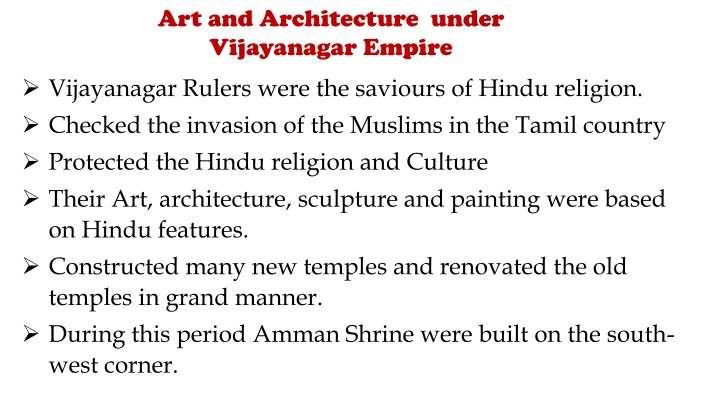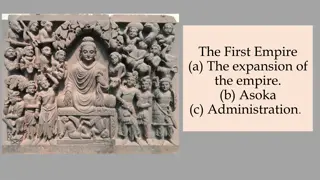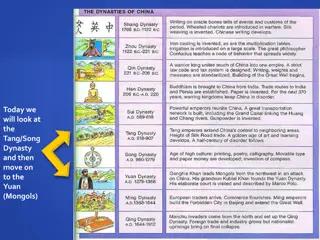Art and Architecture under Vijayanagar Empire
Vijayanagar rulers preserved Hindu religion and culture through splendid art, architecture, and temples. They constructed grand structures, beautified pillars, and classified periods of artistic development. The empire's legacy includes iconic temples like Vidyasankara Temple and significant stages reflected in their construction style. Explore the rich heritage of the Vijayanagar Empire through their artistic endeavors.
Download Presentation

Please find below an Image/Link to download the presentation.
The content on the website is provided AS IS for your information and personal use only. It may not be sold, licensed, or shared on other websites without obtaining consent from the author.If you encounter any issues during the download, it is possible that the publisher has removed the file from their server.
You are allowed to download the files provided on this website for personal or commercial use, subject to the condition that they are used lawfully. All files are the property of their respective owners.
The content on the website is provided AS IS for your information and personal use only. It may not be sold, licensed, or shared on other websites without obtaining consent from the author.
E N D
Presentation Transcript
Art and Architecture under Vijayanagar Empire Vijayanagar Rulers were the saviours of Hindu religion. Checked the invasion of the Muslims in the Tamil country Protected the Hindu religion and Culture Their Art, architecture, sculpture and painting were based on Hindu features. Constructed many new temples and renovated the old temples in grand manner. During this period Amman Shrine were built on the south- west corner.
Beautified the pillars of the temples Build very big halls for public uses like marriage and other functions for instance, Hundred Pillared Halls and Thousand Pillared Halls. Tall gopuras popularly called Rayagopuras. Stones were used in the temple up to first floor and bricks were used in the later portions. Noteworthy features of the temples is the 'Thousand Pillared Halls Horse Hall constructed in the Sri Rangam Temple by Vijayanagar kings. Separate shrine for Alwars and Nayanmars were constructed.
Classified into three stages Early phase 1336-1509 Middle Phase 1509-1565 Later Phase 1565-1650 or Beginning of Nayak phase
Early phase 1336 -1509 Vidyasankara Temple at Sringeri, Karnataka is one of the earliest temples of the Vijayanagar period which built in 1338 it has combinations of Hoysala and Dravidian architecture features. Ganigitti Jaina Temple at Hampi, Karnataka Vardhmana Temple at Jina-Kanchi, Gingee, Villupuram Dist Prasanna-Virupaksha Temple at Mulabagal, Karnataka.
Middle Phase (1509-1565) Construction of large temples with gopuras and mandapas Virupaksha or Pampapat temple considered as the most sacred temple at Hambi. Ranga mandapas of Virupaksha is famous one which built by Krishnadevaraya. Garuda shrine, Vittala temple at Hambi built during this period Hazara Ramesvami Temple, Hambi (KA) and Virabhadra Temple at Lepakshi, Anantapur dist, AP AvantasayanaTemple, Avantasayanagudi, Bellary Dist, Karnataka
Later Phase 1565-1650 Also known as beginning of the Nayak phase after the battle of Talaikottai in 1565 the capital shifted from Chandragiri to Penukonda. Unjal or Tirumalarayan mandapa in Tirumalai temple or Venkateswara Temple built by Krishnadevaraya, Tirupati, AP Kesavaswami Temple at Penukonda, Anandapur dist, AP
Civil Architecture Palaces, ministerial residences, bazaars, entertainment hall, water-supply system and irrigation projects constructed. stone was used for the base and wood, metal, brick were used for the superstructure. pillars were constructed with the use of timber or stone. Lotus Mahal, Stepped Tanks at Hambi best example for the civil architecture of Vijayanagara rulers
Stepped Tank, Hambi(KA) Lotus Temple, Hambi (KA)
Vittala Vittala Temple Temple at at Hambi Hambi (KA) (KA)
Main Features 1. Construction of Amman Shrine in the Temple 2. Construction of Hundred Pillared Hall and Thousand pillared Hall in each and every temple 3. Sculpture decorations in pillars 4. Erection of highest tower at the entrance of the Temples 5. Construction of many prakaras, mandapas like kalyana mandapa, unjal mandapa, vasantha mandapa, vahana mandapa, ranga mandapa and kannadi manadapa. 6. Paintings in inner walls, ceilings and pillars. 7. Painting concept stories of Ramayana and Mahabharatha.























